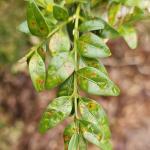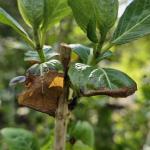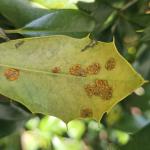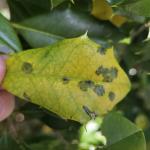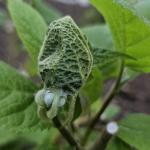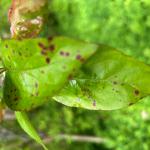UMass Extension's Landscape Message is an educational newsletter intended to inform and guide Massachusetts land care professionals in the management of our collective landscape. Detailed reports from scouts and Extension specialists on growing conditions, pest activity, and cultural practices for the management of woody ornamentals, trees, and turf are regular features. The following issue has been updated to provide timely management information and the latest regional news and environmental data.
Welcome to Landscape Message #6 for the 2024 growing season. The next message will be published in one week, on May 24. To receive immediate notification when the next Landscape Message update is posted, be sure to join our e-mail list
Click on the headings below to jump to that section of the message.
In This Issue
Scouting Information by Region
Woody Ornamentals
Scouting Information by Region
Environmental Data
The following data was collected on or about May 15, 2024. Total accumulated growing degree days (GDD) represent the heating units above a 50ºF baseline temperature collected via regional NEWA stations (http://newa.cornell.edu) for the 2024 calendar year. This information is intended for use as a guide for monitoring the developmental stages of pests in your location and planning management strategies accordingly.
|
MA Region/Location |
2024 Growing Degree Days |
Soil Temp |
Precipitation |
Time/Date of Readings |
||
| Gain since last report |
2024 total |
Sun |
Shade |
|||
|
CAPE |
23 |
76 |
58 |
54 |
0.14 |
12:00 PM 5/15/2024 |
|
SOUTHEAST |
39 |
142 |
63 |
57 |
0.22 |
3:00 PM 5/15/2024 |
|
NORTH SHORE |
34 |
83 |
60 |
53 |
0.05 |
10:00 AM 5/15/2024 |
|
EAST |
42 |
142 |
63 |
57 |
0.41 |
4:00 PM 5/15/2024 |
|
METRO |
46 |
139 |
59 |
55 |
0.44 |
6:00 AM 5/15/2024 |
|
CENTRAL |
45 |
140 |
60 |
56 |
0.91 |
2:00 PM 5/15/2024 |
|
PIONEER VALLEY |
51 |
174 |
66 |
58 |
0.92 |
3:00 PM 5/14/2024 |
|
BERKSHIRES |
29 |
137 |
61 |
56 |
0.28 |
7:00 AM 5/15/2024 |
|
AVERAGE |
39 |
129 |
61 |
56 |
0.42 |
- |
|
n/a = information not available |
||||||
US Drought Monitor: No change from last week... at this time, no area of Massachusetts is under official drought status. State map as of Thursday 5/16: https://droughtmonitor.unl.edu/CurrentMap/StateDroughtMonitor.aspx?MA
Phenology
| Indicator Plants - Stages of Flowering (BEGIN, BEGIN/FULL, FULL, FULL/END, END) | ||||||||
|---|---|---|---|---|---|---|---|---|
| PLANT NAME (Botanic / Common) | CAPE | S.E. | N.S. | EAST | METRO W. | CENT. | P.V. | BERK. |
|
Syringa meyeri (Meyer lilac) |
* |
* |
* |
Begin |
* |
* |
* |
* |
|
Deutzia spp. (deutzia species) |
* |
Full |
* |
Begin |
* |
* |
Begin |
* |
|
Aesculus hippocastanum (common horsechestnut |
Begin |
* |
Begin/Full |
Begin |
* |
* |
Begin |
* |
|
Enkianthus campanulatus (redvein enkianthus) |
* |
Begin |
* |
* |
* |
* |
Begin |
* |
|
Rhododendron carolinianum (Carolina rhododendron) |
Begin |
* |
Begin/Full |
Begin |
* |
Begin |
Begin |
* |
|
Rhododendron catawbiense (catawba rhododendron) |
Begin |
Begin |
* |
* |
* |
* |
Begin |
* |
|
Elaeagnus umbellata (autumn olive) |
Begin/Full |
Full |
Full |
Full |
Full |
Full |
Full |
Begin |
|
Spiraea x vanhouttei (Vanhoutte spirea) |
Full |
Full/End |
Full |
Full |
Full |
Full |
Full |
Begin |
|
Syringa vulgaris (common lilac) |
Begin |
Full |
Full |
Full |
Full |
Full |
Full |
Full |
|
Cornus florida (flowering dogwood) |
Full |
Full |
Full |
Full |
Full |
Full |
Full |
Full |
|
Malus spp. (crabapple) |
Full |
End |
Full |
Full |
Full/End |
Full/End |
Full/End |
Full |
|
Cercis canadensis (redbud) |
Full |
Full |
Full |
Full |
Full/End |
Full/End |
Full/End |
Full |
|
Rhododendron spp.(early azaleas) |
Full |
Full |
Full/End |
Full/End |
Full/End |
Full/End |
Full/End |
Full/End |
| * = no activity to report/information not available | ||||||||
Regional Notes
Cape Cod Region (Barnstable)
General Conditions:
The average temperature for the period from May 8 – May 15 was 52ºF with a high of 67ºF on May 15 and a low of 36ºF on May 12, with a mix of partly cloudy and mostly sunny days. A small amount of precipitation occurred on May 8 around a tenth of an inch. Soil moisture is adequate.
Oaks in the red group have started to flower and release pollen. Herbaceous plants seen in bloom during the period include Siberian bugloss (Brunnera macrophylla), basket of gold (Aurinia saxatilis), moss phlox (Phlox subulata), sweet woodruff (Galium odoratum) and bleeding heart (Dicentra spp.). Woody plants seen in bloom during the period includes fothergilla, Japanese flowering Cherry ‘Kwanzan’, beach plum (Prunus maritima), dwarf fothergilla (Fothergilla gardenii), and flowering quince (Chaenomeles speciosa).
Box tree moth was discovered in several towns of the upper Cape last season. This insect is capable of defoliating boxwood if left unmanaged. Box tree moth is active and should be scouted for;
Be on the lookout for southern pine beetle (SPB). SPB, while similar to black turpentine beetle, produces smaller pitch tubes higher on the trunk.
Insect pests observed during the period include box tree moth caterpillars on boxwood, boxwood leafminer larvae on boxwood (soon to pupate), hemlock elongate scale on hemlock, winter moth on various trees and shrubs, black turpentine beetle adults on pitch pine, and hydrangea leaftier on smooth hydrangea.
Disease symptoms or signs observed during the period include tulip fire on tulip, black knot on Prunus, sycamore anthracnose on sycamore, Volutella blight on boxwood, white pine needle decline on white pine, needlecast on pitch pine, rhizosphaera on spruce, and holly rust on holly.
Seasonal leaf drop on holly has begun, often mistaken for disease-related leaf drop. There have been many inquiries about damage to bigleaf hydrangea caused by freezing temperatures on April 26, as well as deer and rabbit damage to hosta. Slugs and snails are active.
Invasive plants seen in bloom during the period include garlic mustard (Alliaria petiolata), leafy spurge (Euphorbia esula), and autumn olive (Elaeagnus umbellata). Other weeds seen in bloom include dandelions (Taraxacum officinale), yellow rocket (Barbarea vulgaris), narrow-leaved plantain (Plantago lanceolata), red sorrel (Rumex acetosella), and speedwells (Veronica spp.)
Southeast Region (Dighton)
General Conditions:
Over the past week, temperatures have been quite pleasant, with a high of 70ºF on Thursday afternoon, May 14th, and lows hovering around 43ºF on Saturday and Sunday mornings, May 11th and 12th. There were brief but heavy thunderstorms the morning of Wednesday, May 8th, that produced some localized flash flooding. The only other precipitation was light showers Sunday afternoon and again all through the day on Wednesday, May 15. Total accumulation was only a meager 0.22 inches for the week. The highest recorded wind speed was a moderate 16 mph from the south-southeast on Tuesday afternoon, May 14th. The soil temperature in full sun was 63ºF, while shaded soil temperature was 57ºF at 3 PM on Wednesday, May 15th.
Plants currently in flower include: Cercis canadensis (redbud), Cornus florida (native flowering dogwood), Deutzia spp. (Deutzia species), Enkianthus campanulatus (redvein enkianthus), Elaeagnus umbulata (autumn olive), Lonicera tatarica (Tartarian honeysuckle), Prunus serrulata (Japanese flowering cherry), Rhododendron catawba (Catawba rhododendron), Rhododendron mucronulatum (Korean azalea), Rhododendron spp. (early flowering azaleas), Spirea x vanhoutte (Vanhoutte spirea), and Syringa vulgaris (common lilac).
Pests/Problems:
During rainy periods, the orange gelatinous telial horns of cedar apple rust are quite prominent. These release spores which will infect nearby apple trees.
North Shore (Beverly)
General Conditions:
Cool spring weather persisted during this reporting period with sunny or lightly overcast skies and little or no precipitation. Approximately 0.05 inches of rainfall was recorded at Long Hill. Day temperatures were mostly in the mid 50s to low 60s, except on May 14 when day temperatures climbed to 77ºF. Night temperatures were mostly in the low to mid 40s. The average daily temperature was 53ºF, with a high of 77ºF recorded on May 14th, and a low of 36ºF was recorded on May 11th. Woody plants seen in bloom include: beach plum (Prunus maritima), large Fothergilla (Fothergilla major), dwarf Fothergilla (Fothergilla gardenii), flowering dogwood (Cornus florida), little leaf lilac (Syringa microphylla), pink shell azalea (Rhododendron vaseyi), pearlbush (Exochorda racemosa), redbud (Cercis canadensis), common horse chestnut (Aesculus hippocastanum, Kwanzan cherry (Prunus serrulata), black chokeberry (Aronia melanocarpa), and highbush blueberry (Vaccinium corymbosum). Blooming herbaceous plants include honesty plant (Lunaria annua), Solomon's seal (Polygonatum biflorum), bleeding heart (Lamprocapnos spectabilis), forget-me-not (Myosotis sylvatica), golden seal (Hydrastis canadensis), and fairy bells (Disporum uniflorum).
Leaf and flower gall (Exobasidium vaccinii) was observed on azalea. Young leaves and flowers become swollen, fleshy and pale green. As the galls age, they become white with spores of the fungus on the surface. Remove the galls before they become white with spores. Twig blight was observed on juniper. Young needles and twigs are affected, and they have turned brown. Prune and destroy the infected twigs. Apple scab (Venturia inaequalis ) was observed on some crabapples. Collect and discard foliage that is shed throughout the growing season to reduce inoculum at the site. Due to the lack of precipitation during the last seven days, the soil is starting to get dry. Make sure to water recently planted plants. Invasive garlic mustard continues to thrive in the landscape. Other weeds thriving include dandelion (Taraxacum officinale), violets (Viola spp.), ground ivy (Glechoma hederacea), and deadnettle (Lamium purpureum). Take measures to control weeds before they set seed.
East (Boston)
General Conditions:
It was a good week for landscape plants. Daytime temperatures averaged 63ºF with a high of 78ºF on the 14th. Overnight temperatures averaged 46ºF with a low of 39ºF on the 12th. We have had only four days at or above average in May. We had six consecutive days with no precipitation, but we have accumulated 0.82 inches thus far this month from three strategically spaced rain events. Soils remain adequately moist. We are at 125 Growing Degree Days (base 50). Plants in bloom include; Aesculus hippocastanum (horse chestnut), Arisaema triphyllum (Jack-in-the-pulpit), Asimina triloba (paw paw), Camassia quamash (camas lily), Galium odoratum (sweet woodruff), and Viburnum plicatum (doublefile Viburnum).
Pests/Problems:
Peach leaf curl (Taphrina deformans) has been observed on untreated, susceptible Prunus persica (peach). Aphids have begun feeding on Viburnum carlesii (Korean spice bush) foliage, creating contorted, cupped leaves. Gooseberry sawfly larvae (Pristiphora spp.) have been skeletonizing gooseberry (Ribes uva-crispa). Hydrangea leaf tier larvae (Olethreutes ferriferana) have been sewing up the terminal leaves of Hydrangea arborescens ‘Annabelle’. The invasive garlic mustard (Alliaria petiolata) continues with its prolific bloom.
Metro West (Acton)
General Conditions:
Spring is exploding with the recent warm temperatures and rain. We went from spring to summer during this one week reporting period. We started the week with wet and low temperatures near 60ºF and ended the week with warmer and drier weather. A high temperature of 81ºF was recorded on the 14th. The monthly average precipitation for May is 4.04” and I have recorded 0.90” of rain thus far. A small sampling of plants observed in some stage of bloom this past week were the following: Fothergilla major (large Fothergilla), Halesia tetraptera (mountain silverbell), Galium odorata (sweet woodruff), Geranium maculatum (wild geranium), Polygonatum commutatum (great Solomon's seal), Rhododendron vaseyii (pink shell azalea), Stylophorum diphyllum (wood poppy), Trillium grandiflorum (white flowering trillium), Vaccinium corymbosum (highbush blueberry), and Wisteria spp. (wisteria).
Pests/Problems:
Several woody invasive plants are in bloom at this time including Berberis thunbergii (barberry), a small shrub found growing in the wild as well as frequently discovered planted in landscapes, has insignificant flowers; Elaeagnus umbellata (Autumn-olive), a shrub/small tree that can easily be detected by its silvery leaves, light yellow fragrant flowers, and thorny branches; and Lonicera maackii (Amur honeysuckle), a shrub with delicate white/yellow flowers. Alliaria petiolata (garlic mustard) continues to flower and is in full bloom and can easily be spotted because of its white flowers and can be seen growing anywhere and everywhere including on roadsides and in woodlands, wetlands, and gardens.
Central Region (Boylston)
General Conditions:
Seems that we got a sampling of summer recently, maxing out at 87.3ºF on the 14th, in contrast to the average of 58.8ºF since the last report. Along with warmer weather, there seemed to be a bit of a dry period, aside from the 0.89 inches of precipitation received on the 8th. Woody material that is currently blooming are common lilac (Syringa vulgaris), Carolina rhododendron (Rhododendron carolinianum), Rhododendron x ‘Yaku Princess', and witch-alder (Fothergilla spp.). Some herbaceous material such as Trillium spp., Dicentra spp., shooting star (Dodecatheon meadia), and Aquilegia spp. are also blooming now.
Pests/Problems:
Continuing to see a lot of garlic mustard (Alliaria petiolata) flowering around, for which right now is great timing for cutting all of the stems back. Dandelions have also flowered and have started to go to seed quite quickly. Lastly, slugs are beginning to create damage and make their marks throughout foliage of herbaceous material.
Pioneer Valley (Amherst)
General Conditions:
If plants are a big part of your life, then May is the prime month of the year. New growth and endless colors are covering the landscape right now. Changes are happening daily, and it’s dizzying to take it all in. Azaleas and rhododendrons that were devoid of flowers last year, due to the early February freeze, are blanketed in blooms this spring. Redbuds have also had a fantastic flowering period. Most trees and shrubs are really filling out, so shade is increasing dramatically. The shade is good for retaining soil moisture as humidity levels are still generally low and winds have been strong. Despite the wet spring, upper surface soils are drying out in exposed settings. Cloudy skies and light rain at the time of writing should help, but carefully monitor soil moisture levels for new transplants. At deeper horizons, soil moisture is plentiful and after last year’s excessive rainfall, it’s important not to overwater established plants that often don’t require supplemental irrigation, like rhododendron and yew. As we mark the anniversary of last year’s damaging frost on 5/18, we can be thankful that a repeat event did not take place this year.
Pests/Problems:
Scouting for disease and insect pests from a distance is often not effective. Only close examination can detect an insect infestation or disease outbreak so that appropriate treatment can commence. For example, a Fraser fir on the UMass campus appeared relatively healthy from 40’ away, perhaps a bit thin in the canopy with some scattered branch dieback. But when carefully examined, a severe spider mite and elongate hemlock scale infestation was obvious, with chlorotic flecking symptoms abundant on the upper side of the needles. Beech leaf disease (BLD) symptoms are present and detectable as new leaves develop. However, the interveinal banding and cupping may be a bit nuanced on immature leaves when disease severity is low. When BLD cases are more serious, meaning that the nematode populations were high within the infested buds, the newly emerging leaves appear undersized, distorted and possibly thickened. Phosphite applications, as a soil drench around the root flare, may help to slow disease development. Fluopyram foliar sprays can also be performed but this treatment is generally recommended for later in the season and may not be effective if the entire canopy can’t be treated. For trees with high cultural and historical value, injections with Arbotect 20-S are now labeled for use against BLD. Pine candles continue to elongate and needles are starting to form. Symptoms of needle blight on eastern white pine can quickly develop from mid- to late May, peaking in early June. Older needles turn brown and are prematurely shed from the canopy. Symptoms of needle blight on two- and three-needle pines are clearly visible right now and many of the same fungi that attack eastern white pine also occur on hard pines.
Berkshire Region (West Stockbridge)
General Conditions:
After a stretch where nighttime temperatures were typically in the low 30s and upper 20s, temperatures have warmed up considerably over several nights during the past week and are now consistently in the 40ºF range. Day time high temperatures at the 3 NEWA (http://newa.cornell.edu) sites in Berkshire County reached 81ºF in North Adams on May 14, while Richmond and Pittsfield had a high of 77ºF on the 14th. Total precipitation for the three sites was: 0.63 inches at Pittsfield, 0.66 inches in North Adams, and 0.68 inches in Richmond. The combination of mild temperatures and consistently moist soils because of frequent though low amount of rainfall has spurred rapid growth of plant life. Turfgrass, in particular, is growing rapidly, and lawns where “No Mow May” is practiced are showing an abundance of pollinator-attracting flowers, often referred to as weeds. These include common blue violet (Viola sororia), dandelion (Taraxacum spp.), white clover (Trifolium repens), creeping Charlie (Glechoma hederacea), and common buttercup (Ranunculus acris). Beyond lawn weeds, i.e. flowers, there is a great variety of flowering trees, shrubs, and herbaceous perennials lighting up landscapes.
Pests/Problems:
Plant pest and disease pressures remain low at this time. Boxwood leafminer is still in the pupal stage. Hydrangea leaftiers have made an appearance. The deer tick and mosquito population remains high. Likewise, Asian jumping worms are abundant in garden soils and lawn soils. Slugs and snails are taking advantage of the moist conditions and can be found dining especially on plant foliage in contact with the ground. A few diseases have made an appearance, most notably apple scab on crabapples. Yellow colored gall was observed on the stems of a rose bush. Shoot dieback was observed on several plant species, including boxwood and copper beech. Though deer have redirected most of their diet to lush grass, rabbits continue to feed on many plants in flower borders.
Regional Scouting Credits
- CAPE COD REGION - Russell Norton, Horticulture and Agriculture Educator with Cape Cod Cooperative Extension, reporting from Barnstable.
- SOUTHEAST REGION - Brian McMahon, Arborist, reporting from the Dighton area.
- NORTH SHORE REGION - Geoffrey Njue, Green Industry Specialist, UMass Extension, reporting from the Long Hill Reservation, Beverly.
- EAST REGION - Kit Ganshaw & Sue Pfeiffer, Horticulturists reporting from the Boston area.
- METRO WEST REGION – Julie Coop, Forester, Massachusetts Department of Conservation & Recreation, reporting from Acton.
- CENTRAL REGION - Mark Richardson, Director of Horticulture, and Anna Petrie, reporting from New England Botanic Garden at Tower Hill, Boylston.
- PIONEER VALLEY REGION - Nick Brazee, Plant Pathologist, UMass Extension Plant Diagnostic Lab, reporting from Amherst.
- BERKSHIRE REGION - Ron Kujawski, Horticultural Consultant, reporting from Great Barrington.
Woody Ornamentals
Diseases
Recent pests, pathogens, or problems of interest seen in the UMass Extension Plant Diagnostic Lab, a select few:
Branch cankering and shoot tip blight on a Hollywood juniper (Juniperus chinensis ‘Kaizuka’) caused by cedar-quince rust (Gymnosporangium clavipes) and Phomopsis canker (Phomopsis sp.). The tree is approximately 30 years old and has been present at the site for 24 years. The site is within view of the ocean and while it includes full sun there are extended periods of fog and mist. Soils are loam-based with good drainage and there is no supplemental irrigation. Over the past two years, the tree has exhibited scattered shoot tip blight and swollen cankers that become blackened over time. The cedar-quince rust pathogen creates swollen galls on Juniperus stems and branches that, despite encircling the stem tissue, do not always cause mortality. Thus, some cankers become larger each year and serve as a perennial source of inoculum. The cankers can then be colonized by opportunistic cankering fungi, like Diplodia and Phomopsis. The latter was present in this case and typically these secondary attacks result in death of the shoot tip or larger branch.
Needle browning and lower canopy branch dieback on a weeping Serbian spruce (Picea omorika ‘Pendula Bruns’) due to winter injury and transplant shock. The tree is approximately 12’ tall and was transplanted along with other mature conifers into a residential landscape three years ago. It experiences full sun in a mulched bed with loam soils and drip irrigation. Last spring, needle browning in the lower canopy developed and was likely the result of cold injury during the winter of ‘22–‘23. Transplant shock can make otherwise hardy conifers more susceptible to cold injury. This past winter (‘23–‘24), the needle browning worsened and now a significant portion of the lower canopy is symptomatic. The submitted shoots had needles that were pale brown but lacked any disease symptoms. After incubation, no needle blight or cankering pathogens were present, but there was an array of saprophytic fungi present. This can suggest that tissue was killed by an abiotic stress and subsequently colonized.
Lower trunk rot within a red oak (Quercus rubra) on the UMass campus due to an unknown decay pathogen. The tree is old and large with a dbh of 51”. It resides in a long and wide tree belt on the southwestern side of campus, where many large and mature trees are left relatively undisturbed. The tree appears relatively healthy but has a large branch tear-out wound on the trunk roughly ~30’ from the ground, exposing a significant cavity. The tree was scanned for internal decay in the lower trunk using sonic and electrical resistance tomography in 2017. At the time, serious decay was detected with approximately 65% of the cross-sectional area damaged at ~12” above the soil line. The tree was rescanned this week and the current set of tomograms appear nearly identical to the ones captured seven years ago. At the same lower sampling height (12” from soil line), approximately 63% of the cross-sectional area is damaged from decay. Interestingly, the diameter of the trunk at this height has increased from 69” (2017) to 72” (2024). Therefore, despite the large size and advanced age, this oak continues to accrue diameter, keeping pace with the rate of decay over this time interval.
Report by Nick Brazee, Plant Pathologist, UMass Extension Plant Diagnostic Lab, UMass Amherst
Insects and Other Arthropods
The Professional Insect and Mite Management Guide for Woody Plants is freely available at https://ag.umass.edu/insectmiteguide. Please let me know how it is or isn’t working for you by responding to the following Feedback Form: Professional Insect & Mite Management Guide for Woody Plants. Your feedback is valuable and I cannot wait to hear from you!
Note: Our website is undergoing updates, and as such, the collapsible menus on the home page of the Guide are currently not functioning. Thank you for your patience as we await these updates.
Invasive Updates:
- Asian Longhorned Beetle is still present in Worcester, Shrewsbury, Boylston, West Boylston, and parts of Holden and Auburn, MA. If you suspect you’ve found this insect or the damage it causes, please report it to the Asian Longhorned Beetle Eradication Program office in Worcester, MA at 508-852-8090 or toll free at 1-866-702-9938.
To report an Asian longhorned beetle find online or to compare it to common insect look-alikes, visit: http://massnrc.org/pests/albreport.aspx
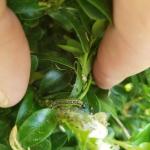 Box Tree Moth has been detected in the following Massachusetts communities: Bourne, Sandwich, and Barnstable. A map of these locations is available at MDAR’s Invasive Pest Dashboard. If you believe you have found this insect, please take a photo, note your location, and report it immediately to the MA Department of Agricultural Resources using their Report a Pest Form. Box tree moth caterpillars were reported to be active at certain locations on Cape Cod, MA as of the week of April 19th. See Landscape Message #3 and the Cape Cod Region Report.
Box Tree Moth has been detected in the following Massachusetts communities: Bourne, Sandwich, and Barnstable. A map of these locations is available at MDAR’s Invasive Pest Dashboard. If you believe you have found this insect, please take a photo, note your location, and report it immediately to the MA Department of Agricultural Resources using their Report a Pest Form. Box tree moth caterpillars were reported to be active at certain locations on Cape Cod, MA as of the week of April 19th. See Landscape Message #3 and the Cape Cod Region Report.
Need information about monitoring and trapping box tree moth? Check out this newly available Box Tree Moth Monitoring & Trapping fact sheet from UMass Extension.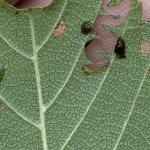
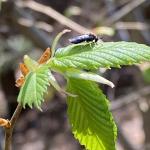 Elm Zigzag Sawfly has been detected in the following Massachusetts communities: Becket, Chester, Windsor, and Williamstown. If you believe you have found this insect, please take a photo, note your location, and report it immediately using MA DCR’s Massachusetts Elm Zigzag Sawfly Reporting Form. Elm zigzag sawfly adults are active as of 5/2/2024 at a previously infested site in Berkshire County (first detected in 2023). See photo courtesy of Nicole Keleher, MA DCR Forest Health Program.
Elm Zigzag Sawfly has been detected in the following Massachusetts communities: Becket, Chester, Windsor, and Williamstown. If you believe you have found this insect, please take a photo, note your location, and report it immediately using MA DCR’s Massachusetts Elm Zigzag Sawfly Reporting Form. Elm zigzag sawfly adults are active as of 5/2/2024 at a previously infested site in Berkshire County (first detected in 2023). See photo courtesy of Nicole Keleher, MA DCR Forest Health Program.- Emerald Ash Borer is well established across most of Massachusetts. A map of these locations from the MA Department of Conservation and Recreation is available.
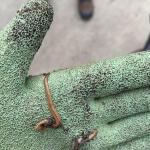
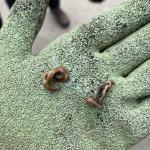 Hammerhead Worms: Also known as flatworms or land planarians, belong to Phylum Platyhelminthes (flat worms) rather than Arthropoda (arthropods) which makes them different from insects and their relatives. Class Insecta is the taxonomic classification of the Insects, whereas hammerhead worms belong to Class Turbellaria. A few common species of non-native hammerhead worms noted in New England include but are not limited to: Bipalium kewense, Bipalium adventitium, and Bipalium pensylvanicum. For more information, see this article in Hort Notes on Hammerhead Worms in New England.
Hammerhead Worms: Also known as flatworms or land planarians, belong to Phylum Platyhelminthes (flat worms) rather than Arthropoda (arthropods) which makes them different from insects and their relatives. Class Insecta is the taxonomic classification of the Insects, whereas hammerhead worms belong to Class Turbellaria. A few common species of non-native hammerhead worms noted in New England include but are not limited to: Bipalium kewense, Bipalium adventitium, and Bipalium pensylvanicum. For more information, see this article in Hort Notes on Hammerhead Worms in New England.
Sightings of these organisms have increased in recent years, possibly due to warming winters and wet summers. Hammerhead worms are predators that prefer to feed on earthworms; however, depending upon the species involved, they may not be an effective predator of certain species of jumping worms. Again in 2024, reports of hammerhead worms have come from parts of Massachusetts (in this case, Martha’s Vineyard; see photos) with questions about safety. Hammerhead worms are known to produce a neurotoxin (tetrodotoxin) which they use in self-defense and to subdue prey. Luckily, hammerhead worms do not produce enough tetrodotoxin to be lethal to humans, but if the neurotoxin comes into contact with exposed skin, irritation may occur. It is advised that handling hammerhead worms should be avoided, and hands or exposed skin be washed with soap and water following any accidental contact.- Jumping Worms are non-native earthworms that impact natural ecosystems. Available resources include a fact sheet about earthworms in Massachusetts and jumping worm FAQ’s.
- Spotted Lanternfly now has established populations in the following locations in Massachusetts: Holyoke, Springfield, West Springfield, Agawam, Fitchburg, Worcester, Shrewsbury, Southborough, Ashland, Wellesley, Weston, and Chelmsford. The MA Department of Agricultural Resources reports that spotted lanternfly egg hatch has begun in Holyoke and Springfield, MA as of 5/14/2024. Now is the time to monitor egg masses and areas nearby for emerging early instar nymphs (immatures). If you believe you have found this insect, please take a photo, note your location, and report it immediately using the Spotted Lanternfly Report Form. Available resources include a map of spotted lanternfly locations in Massachusetts from the MA Department of Agricultural Resources, MDAR’s spotted lanternfly fact sheet, UMass Extension’s Spotted Lanternfly Management Guide, and an SLF InsectXaminer episode.
Medically Important Pests:
- Ticks are a serious public health concern and may be active in managed landscapes any time temperatures are above freezing. Encounters with deer ticks can increase in New England in April, October, and November; however, precautions should be taken year-round to prevent tick bite exposure. Available resources include tick information from Cape Cod Cooperative Extension, personal protective measures, and a list of potential tick testing resources. The New England Center of Excellence in Vector-Borne Diseases (NEWVEC) also provides the latest tick information and resources.
- Mosquitoes and the diseases they vector are also a serious public health concern in Massachusetts by summer. Available resources include Mosquito Repellents from the Department of Public Health and Prevent Mosquito Bites from the Centers for Disease Control and Prevention. The Massachusetts Department of Public Health tests for Eastern Equine Encephalitis (EEE) and West Nile Virus (WNV) from June to October. Beginning in June, Massachusetts risk maps will be available.
- Wasps/Hornets: Many wasps are predators of other arthropods, including pest insects such as certain caterpillars that feed on trees and shrubs. Adult wasps hunt prey and bring it back to their nest where young are being reared as food for the immature wasps. A common such example are the paper wasps (Polistes spp.) who rear their young on chewed up insects. Paper wasps can sting, and will defend their nests, which are open-celled paper nests that are not covered with a papery “envelope”. These open-celled nests may be seen hanging from eaves or other outdoor building structures. Aerial yellow jackets and hornets create large aerial nests that are covered with a papery shell or “envelope”. Common yellow jacket species include those in the genus Vespula. Dolichovespula maculata is commonly known as the baldfaced hornet, although it is not a true hornet. The European hornet (Vespa crabro) is three times the size of a yellow jacket and may be confused for the northern giant hornet (Vespa mandarinia). The European hornet is known to Massachusetts, but the northern giant hornet is not. If you are concerned that you have found or photographed a northern giant hornet, please report it using the MA Department of Agricultural Resources Report Pest Sightings page. Some people are allergic to stinging insects, so care should be taken around wasp/hornet nests. Unlike the European honeybee (Apis mellifera), wasps and hornets do not have barbed stingers and therefore can sting repeatedly when defending their nests. It is best to avoid them and, if that cannot be done and assistance is needed to remove them, consult a professional.
Tree & Shrub Insect & Mite Pest Suggested Scouting:
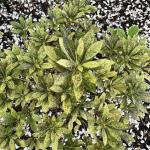 Andromeda Lace Bug is most commonly encountered on Japanese andromeda, however other host plants may be impacted. Most activity from this insect occurs between late May through September, with several generations occurring per year. Both nymphs and adults feed on host plant leaf undersides and cause white/yellow-colored spots or chlorosis to occur on host plant leaf surfaces. This image from 5/9/2024 (Boston, MA) shows Pieris japonica ‘Cavatine’ with old andromeda lace bug feeding damage from 2023 and possible winter injury. Samples were submitted to the UMass Extension Plant Diagnostic Lab. As of now, the new growth is starting to show damage as well, after developing without it. Boston, MA was at 132 GDD’s on 5/12/2024 and andromeda lace bug is known to begin activity by 120 GDD’s. (Image courtesy of Susan Shafer.)
Andromeda Lace Bug is most commonly encountered on Japanese andromeda, however other host plants may be impacted. Most activity from this insect occurs between late May through September, with several generations occurring per year. Both nymphs and adults feed on host plant leaf undersides and cause white/yellow-colored spots or chlorosis to occur on host plant leaf surfaces. This image from 5/9/2024 (Boston, MA) shows Pieris japonica ‘Cavatine’ with old andromeda lace bug feeding damage from 2023 and possible winter injury. Samples were submitted to the UMass Extension Plant Diagnostic Lab. As of now, the new growth is starting to show damage as well, after developing without it. Boston, MA was at 132 GDD’s on 5/12/2024 and andromeda lace bug is known to begin activity by 120 GDD’s. (Image courtesy of Susan Shafer.)- Arborvitae Leafminer moths appear from mid-June to mid-July and lay their eggs. Eggs hatch and larvae enter the leaves where they feed, often unnoticed until January or February when browned leaf tips become more apparent. Feeding from this insect is sometimes confused for winter injury, and vice versa.
- Azalea Lace Bug is a pest of both deciduous and evergreen azaleas (Rhododendron spp.), however resistance has been reported in Rhododendron atlanticum, R. arborescens, R. canescens, R. periclymenoides, and R. prunifolium. The insects feed on host plant leaf undersides, and cause chlorosis on leaf surfaces. Azalea lace bugs are active from 120+ GDD’s throughout the summer.
- Azalea Sawflies is a common name that might refer to three different species of sawflies that feed on azaleas. Adults of Amauronematus azaleae are often present in May and laying eggs which hatch into larvae that typically mature by July 1st. At that time, they finish feeding and drop to the soil to pupate. These green larvae feed on the edges of host plant leaves and may defoliate the plant.
- Bagworm is overwintering on Juniperus spp., Thuja spp., Quercus spp., Platanus spp., and others as 500-1000 eggs can be found in the bags of last season’s deceased females. Now is the time to remove and destroy overwintering bags of eggs prior to egg hatch at approximately 600 GDD’s (approx. mid-June).
 Balsam-fir Root Aphid was reported by a Christmas tree grower in Athol, MA on young transplants on 4/30/2024. This aphid alternates between ash or lilac species host plants and the roots of fir, including Fraser fir (Abies fraseri) such as what is pictured here. It is uncertain the amount of damage this root aphid may cause on fir species host plants. It is likely negligible on mature or established trees without additional stress factors. Young plants may experience some loss of fine roots when aphid numbers exceed 100 per seedling.
Balsam-fir Root Aphid was reported by a Christmas tree grower in Athol, MA on young transplants on 4/30/2024. This aphid alternates between ash or lilac species host plants and the roots of fir, including Fraser fir (Abies fraseri) such as what is pictured here. It is uncertain the amount of damage this root aphid may cause on fir species host plants. It is likely negligible on mature or established trees without additional stress factors. Young plants may experience some loss of fine roots when aphid numbers exceed 100 per seedling. - Black Turpentine Beetle overwinters as an adult in the bark of its host plants. Adults may become active as temperatures rise, typically by mid-April to mid-May. Attacked host trees may ooze 1.6 inch diameter red or white masses of pitch from the lower 6 feet of the trunk. Pitch pine, eastern white pine, and other species of pine or spruce may be hosts for this insect. Frequently an issue on stressed trees in eastern Massachusetts. Favored by drought or flooding conditions.

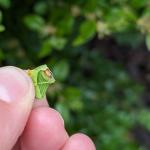 Boxwood Leafminer adult emergence occurs by mid-May, with pupal cases left behind clinging to leaves. Boxwood leafminer pupae were found in boxwood leaves in Berkshire County (Dalton, MA) on 5/11/2024. Shake bushes to detect flying adults. Resistant varieties of boxwood are available; see preceding link.
Boxwood Leafminer adult emergence occurs by mid-May, with pupal cases left behind clinging to leaves. Boxwood leafminer pupae were found in boxwood leaves in Berkshire County (Dalton, MA) on 5/11/2024. Shake bushes to detect flying adults. Resistant varieties of boxwood are available; see preceding link.- Boxwood Mite feeds on upper and lower leaf surfaces of Buxus spp. hosts. Overwintered eggs hatch into larvae in the spring, which mature into nymphs and eventually adults. The entire life cycle takes approximately 18-21 days. Most feeding injury occurs in the spring and hosts may appear off-color.
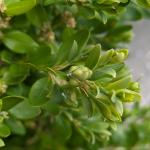
 Boxwood Psyllid nymphs have overwintered within eggshells inserted between bud scales last summer. As soon as buds expand, nymphs will emerge and begin feeding on Buxus spp. developing buds and leaves. Upward cupping and yellowing of leaves can be a sign of previous or current season’s damage. Boxwood psyllids are actively feeding in Berkshire County (Dalton, MA) as seen on 5/11/2024. White, waxy wool created by the insects can be seen in new growth that has already cupped around the insects.
Boxwood Psyllid nymphs have overwintered within eggshells inserted between bud scales last summer. As soon as buds expand, nymphs will emerge and begin feeding on Buxus spp. developing buds and leaves. Upward cupping and yellowing of leaves can be a sign of previous or current season’s damage. Boxwood psyllids are actively feeding in Berkshire County (Dalton, MA) as seen on 5/11/2024. White, waxy wool created by the insects can be seen in new growth that has already cupped around the insects.- Cankerworms can be found feeding on similar host plants in the spring, despite fall and spring cankerworm being different species of insects. Spring cankerworm adult moths are active in February and March, laying masses of 100 or so eggs in the rough bark of larger branches or the trunk of the host plant. Fall cankerworm adults laid their masses of eggs on host plant branches and twigs, back in late November and early December of last year (sometimes the current year’s January). Egg hatch of both species will occur by approximately mid-May, with caterpillar feeding through roughly the end of June.
- Cooley Spruce Gall Adelgid typically overwinters as an immature female near spruce twig terminals. By early spring, this female matures into a stem mother which will lay hundreds of eggs on lateral terminals. Following egg hatch, nymphal feeding induces gall formation on spruce hosts. Green galls on spruce may be removed and destroyed. On Douglas fir, the Cooley spruce gall adelgid’s alternate host, look for woolly masses in the spring and distorted or crooked needles. Do not plant spruce and Douglas fir close together when possible.
- Dogwood Borer is a species of clearwing moth whose larvae bore not only into dogwood (Cornus), but hosts also include flowering cherry, chestnut, apple, mountain ash, hickory, pecan, willow, birch, bayberry, oak, hazel, myrtle, and others. Kousa dogwood appears to be resistant to this species. Signs include the sloughing of loose bark, brown frass, particularly near bark cracks and wounds, dead branches, and adventitious growth. The timing of adult emergence can be expected when dogwood flower petals are dropping and weigela begins to bloom. Adult moth flights continue from then until September.
- Dogwood Sawfly overwinters as a larva in an overwintering “cell” created in soft, decaying wood material. Pupation occurs in the spring, and adults may emerge by late May through July. Eggs are laid in the underside of the host plant leaf, in groups of 100 or more.
- Eastern Spruce Gall Adelgid overwinters as a partially grown female, maturing into a stem mother by early spring. Stem mothers lay 100-200 eggs by budbreak. Eggs hatch and nymphs feed on the needles of their Picea spp. hosts. As green galls develop, prune out and destroy when possible.
- Eastern Tent Caterpillar overwintering eggs hatch in the spring and caterpillars emerge as cherry leaves begin to open. Look for groups of caterpillars feeding in silken tents at that time. Egg masses, caterpillars, and small tents are active now.
- Elm Leaf Beetle overwinters as an adult in protected areas, such as the loose bark of trees. Sometimes, they enter homes in search of a safe winter haven, and become a nuisance. As host plant leaves emerge, beetles fly back to chew small, semi-circular holes in the leaves. Eggs are laid in clusters on leaves and resemble pointy footballs. Each female can lay 600-800 eggs.

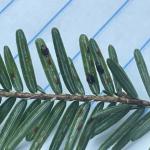 Elongate Hemlock Scale is primarily a pest of hemlock and fir. Overwintered fertilized females or their eggs will become active with warming temperatures, with egg hatch generally occurring by the end of May or the beginning of June. At that time, crawlers will be present before they settle to feed on a needle. Colletotrichum fioriniae was observed on elongate hemlock scales in Lynnfield, MA on 2/23/2024 and again in Manchester, MA on 3/19/2024 by Richard Grant (see photos). C. fioriniae is an endophytic fungus that lives within the needles of hemlock. Up to 90% mortality can occur in elongate hemlock scale if this fungus invades the insect. Scales appear coated in a black material, looking similar to sooty mold (it is not sooty mold). This fungus was reported as active in elongate hemlock scale populations in western MA in 2023 as well.
Elongate Hemlock Scale is primarily a pest of hemlock and fir. Overwintered fertilized females or their eggs will become active with warming temperatures, with egg hatch generally occurring by the end of May or the beginning of June. At that time, crawlers will be present before they settle to feed on a needle. Colletotrichum fioriniae was observed on elongate hemlock scales in Lynnfield, MA on 2/23/2024 and again in Manchester, MA on 3/19/2024 by Richard Grant (see photos). C. fioriniae is an endophytic fungus that lives within the needles of hemlock. Up to 90% mortality can occur in elongate hemlock scale if this fungus invades the insect. Scales appear coated in a black material, looking similar to sooty mold (it is not sooty mold). This fungus was reported as active in elongate hemlock scale populations in western MA in 2023 as well.- Euonymus Caterpillar tiny, overwintered larvae have spent their time beneath eggshells from last year. As temperatures increase in the spring, groups of caterpillars will begin feeding on newly emerging Euonymus spp. leaves. Additional resources include an InsectXaminer episode about euonymus caterpillar.
- Euonymus Scale overwinters as a fertilized female. Eggs are laid beneath dark brown female scale covers in the early spring. Egg hatch occurs over a 2-3 week period, with crawlers present by early June. While Euonymus spp. host plants are preferred, additional host plants have been reported.
- European Elm Scale is a non-native scale that is widespread in North America on native and European elms, in addition to hackberry and Zelkova. Adult females are black with a ring of white fibers around their bodies and may be found in branch forks or rough/creviced areas of the bark. By the end of June, females will produce eggs that hatch into crawlers. Crawlers will disperse to the underside of elm leaves and leaf midveins to feed.

 European Pine Sawfly eggs have overwintered in slits in last year’s needles. Egg hatch begins in approximately late-April and early May. Young European pine sawfly caterpillars were seen feeding in Berkshire County (Dalton, MA) on 5/11/2024. Look for tiny, gray-green larvae with black heads feeding on favored host plants such as Jack, Japanese red, Mugo, red, Scots, or Table Mountain pine. Sawfly larvae will feed until roughly early June, at which time they drop to the ground to pupate.
European Pine Sawfly eggs have overwintered in slits in last year’s needles. Egg hatch begins in approximately late-April and early May. Young European pine sawfly caterpillars were seen feeding in Berkshire County (Dalton, MA) on 5/11/2024. Look for tiny, gray-green larvae with black heads feeding on favored host plants such as Jack, Japanese red, Mugo, red, Scots, or Table Mountain pine. Sawfly larvae will feed until roughly early June, at which time they drop to the ground to pupate.- Fletcher Scale is a soft scale pest of yew, juniper, and arborvitae. Feeding scales, especially on yew, result in honeydew and sooty mold, needle yellowing, and at times, premature needle drop. There is one generation per year. Nymphs develop and adult females lay eggs (on average 500-600) in May that hatch by June. Dead females conceal egg masses beneath. Crawlers migrate short distances to branches and may be concentrated on certain branches of a particular plant.
- Forest Tent Caterpillar egg masses overwinter and will hatch as leaves expand in the spring. Small caterpillars will search for expanding flower and leaf buds to begin feeding on.
- Hemlock Looper collectively refers to two species of geometrid (inchworm; looper) caterpillars. Overwintered eggs hatch by late May or early June, at which time young larvae begin their messy feeding on host plant needles. Hemlock and balsam fir are preferred hosts.
- Hemlock Woolly Adelgid has been favored this winter by the mild temperatures we’ve experienced in Massachusetts, according to the MA Department of Conservation and Recreation. Very little overwintering mortality has been measured at sites sampled across the state.
- Holly Leafminer is the common name of up to seven species of leaf mining flies that feed on holly (Ilex spp). Phytomyza ilicicola is usually referred to as the native holly leafminer. This species is known to feed on Ilex opaca, I. crenata, and related cultivars; however, it only lays its eggs in American holly (Ilex opaca). Some research suggests that the native holly leafminer may lay its eggs in other Ilex species, but that the larvae are unable to complete their development. Adult flies are known to emerge over a period of 6 or so weeks in the spring by mid-May (192-298 GDD’s, base 50°F). Phytomyza ilicis is usually only referred to as the holly leafminer, and it is a non-native species introduced from Europe and only feeds on Ilex aquifolium. (The native holly leafminer does not develop on I. aquifolium.) The biology and damage this insect causes is similar to that of the native holly leafminer, with the exception of the fact that eggs are laid in the midvein of the leaf and young larvae tunnel in the vein until the fall. Adults may be present mid-late May (246-448 GDD’s, base 50°F).
- Honeylocust Plant Bug feeding results in tiny yellowish-brownish spots on leaves, leaf distortion, and in some cases, defoliation. (There are at least 7 species of plant bugs that feed on honeylocust, Gleditsia triacanthos.) There is one generation per year. Immatures and adults feed on foliage and light to moderately damaged foliage may persist throughout the growing season. Honeylocust plant bugs overwinter as eggs laid just beneath the bark surface of 2 and 3 year old twigs. Eggs hatch just after vegetative buds of the host begin to open. Young nymphs crawl to the opening leaflets and begin feeding and the most significant damage occurs at that time, when the insect is hidden from view. Nymphs develop into adults around May-July. This insect can be targeted between 58-246 GDD’s, base 50°F.
- Hydrangea Leaftier caterpillars use silk applied to the edges of two newly expanding hydrangea leaves to tie them together to create an envelope-like structure within which they feed. Search the tips of plant stems. Envelope or purse-like structures may be pulled apart and caterpillars detected within. Caterpillars may mature and pupate by June.
- Imported Willow Leaf Beetle adults overwinter in loose bark or other sheltered areas near susceptible Salix and Populus spp. host plants. Once the host plant leaves emerge in the spring, adults will begin to feed and lay tiny, yellow eggs in clusters on leaf undersides. Additional resources include an InsectXaminer episode about imported willow leaf beetle.
- Lecanium Scales, including most notably in Massachusetts, the oak lecanium, are soft scales that overwinter on host plant twigs as second instar immatures. In the spring, these immatures begin feeding and mature into hemispherical shaped adult females who lay their eggs by late May and into June. Between April and May, much honeydew (sugary excrement) may be produced by the active adult females.
- Lilac Borer is a clearwing moth pest of lilac, privet, fringetree, and ash. (It is also known as the ash borer, not to be confused with the emerald ash borer.) Adults mimic paper wasps. Larvae are wood-boring, and signs and symptoms include branch dieback, holes, and occasionally, sawdust-like frass accumulated on bark. Larvae bore into stems, trunks, and branches, chewing an irregularly shaped entrance hole. Peak adult moth flights may occur in the northern portion of this insect’s range in June and is usually over by August 1st. Pheromone traps can be used to time adult emergence. Adult females lay flattened, oval, and tan eggs that are deposited singly or in clusters on bark crevices, ridges, and sometimes smooth bark; but usually laid in or near wounds in the bark. On average, 395 eggs are laid by each female. After hatch, larvae chew into the bark and feed laterally and then vertically in phloem tissue. Larvae overwinter in tunnels in the final instar and resume feeding in the spring. Adults emerge through a round exit hole (4-5 mm. in diameter). This insect may be targeted between 200-299 GDD’s, base 50°F.
- Lily Leaf Beetle, while not a pest of trees and shrubs, can be an important insect found in ornamental landscapes. As soon as lilies break through the ground in the spring, bright red overwintered adult beetles begin feeding on the foliage. This typically occurs in April, with adults mating and laying eggs by May; 250-450 eggs may be laid per female. Additional resources include an InsectXaminer episode about lily leaf beetle.
- Magnolia Scale overwinters as nymphs (immatures) found on 1 and 2-year old twigs of the host plant. Nymphs begin feeding as temperatures warm in the spring, molting once by late April or May and again by early June.
- Pitch Mass Borer overwinters in the pitch mass found on the host plant. This insect tunnels beneath the bark, into the cambium. It may take up to two years for the pitch mass borer to mature. Pupation typically occurs by the end of May through June, in time for adult clearwing moth emergence in July and August.
- Privet Thrips are a non-native insect pest of privet, lilac, and ash. Thrips feed on the leaves of privet, causing them to appear gray in color made up of chlorotic spots. Immature thrips may be viewed with magnification on the undersides of host plant leaves. Several generations per year may be possible throughout the summer.
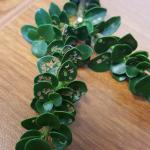
 Redheaded Flea Beetle (Systena frontalis) has been identified as a native pest of nurseries in many locations in the eastern United States. Suspected redheaded flea beetle damage was seen on Ilex crenata 'Dwarf Pagoda' (Dwarf Pagoda Japanese holly) on 3/27/2024 that was purchased in Massachusetts but may have originated in NJ. While identification of this species of insect is uncertain based on host plant damage alone, it appears to be a reasonable and educated assumption. Redheaded flea beetles are known to feed on a wide variety of host plants. These include but are not limited to: cabbage, beans, beets, blueberries, and other agricultural crops as well as Physocarpus, Weigelia, Cornus, Forsythia, Itea, Hydrangea, and Ilex. Adult beetles are active and feed from approximately late-June to mid-September on the upper and lower leaf surfaces of their hosts. This can cause damage that looks like skeletonization and eventually holes in the leaves. Leaves appear covered in brown patches as in these photos. This damage was caused last season on this evergreen plant.
Redheaded Flea Beetle (Systena frontalis) has been identified as a native pest of nurseries in many locations in the eastern United States. Suspected redheaded flea beetle damage was seen on Ilex crenata 'Dwarf Pagoda' (Dwarf Pagoda Japanese holly) on 3/27/2024 that was purchased in Massachusetts but may have originated in NJ. While identification of this species of insect is uncertain based on host plant damage alone, it appears to be a reasonable and educated assumption. Redheaded flea beetles are known to feed on a wide variety of host plants. These include but are not limited to: cabbage, beans, beets, blueberries, and other agricultural crops as well as Physocarpus, Weigelia, Cornus, Forsythia, Itea, Hydrangea, and Ilex. Adult beetles are active and feed from approximately late-June to mid-September on the upper and lower leaf surfaces of their hosts. This can cause damage that looks like skeletonization and eventually holes in the leaves. Leaves appear covered in brown patches as in these photos. This damage was caused last season on this evergreen plant.- Rhododendron Borer is one of the smallest of the native clearwing moths. Adult emergence may begin in May and can last through July, depending upon local temperatures. Rhododendron are preferred host plants, with the larvae of this species boring into stems, often near the base of plants. Injured plant parts may be more attractive to these insects.
- Roseslugs is a common name for at least two species of sawflies whose larvae may be found feeding on the foliage of roses. These small larvae will skeletonize the upper leaf surface and leave a “windowpane”-like pattern behind. If present in large numbers, entire shrubs can be defoliated. Monitor for feeding larvae from the end of May through June.
- Southern Pine Beetle has been trapped in Massachusetts since 2015. By 2022 and 2023, southern pine beetle has reached outbreak conditions in small areas of the state, killing pitch pine (Pinus rigida). (Particularly on Martha’s Vineyard and Nantucket islands in MA.) If you believe you have found infested pitch pine in Massachusetts, please report southern pine beetle using the Massachusetts Southern Pine Beetle Reporting Form from MA DCR.
- Spruce Bud Scale overwinters as an immature scale on the undersides of host plant needles. Once spring temperatures warm, the dormant scales become active by late March and in April female spruce bud scales move to host plant twigs. Adult females are reddish-brown and round, and usually found at the base of new twig growth. In this location, they finish maturing and eggs are retained in the female spruce bud scale body cavity where, eventually, crawlers develop. These immature and mobile crawlers appear by approximately the beginning of June and may remain active through July. They then find suitable locations to settle and begin their feeding on the new growth of the plant. During this time, copious amounts of honeydew (sugary liquid excrement) may be excreted.
- Spruce Spider Mite is a cool season mite which causes most of its feeding damage on coniferous hosts in the spring and fall. Monitor for discolored needles and the mites themselves. Monitoring for spruce spider mite can be done by shaking 3-4 branches over a white piece of paper and viewing mites with a hand lens.
- Taxus Mealybug is commonly a pest of Taxus spp. in New England, but can also be found on dogwood, rhododendron, Prunus spp., maple, andromeda, and crabapple. First instar nymphs overwinter, and in April and May it might be difficult to find these insects. However, by mid-June the population can increase considerably. Taxus mealybug feeding can lead to sparse plants covered in honeydew (sugary liquid excrement).
- Tuliptree Scale is a soft scale pest of Liriodendron and Magnolia spp. among others. Second instar nymphs overwinter, begin feeding as temperatures warm in the spring, and mature into adults by the late spring/early summer.
- Viburnum Leaf Beetle eggs should be hatching during the month of May. The young larvae are approximately 1 mm in length and greenish-yellow in color. They may also be off-white and they lack spots. Larger larvae may appear yellowish-brown or green with black spots and may grow up to ½ inch in length. Larvae may be found anywhere on the leaves and usually in groups. When young, larvae feed on the undersides of the leaves. As they grow larger, they may feed on the upper surface. Larval development may take approximately 8-10 weeks to complete and 3 larval instars are reported. Pupae are yellowish and are found in the soil beneath the host plant. Adults emerge around the middle of July and are brown, smaller than the largest larvae (approximately ¼ inch), and will also feed on the leaves. Adults are present in the landscape until the first hard frost.
- White Pine Aphid is a large, black, long-legged aphid found on twigs and small branches of eastern white pine. Search for aphids beginning in May and June. As the season progresses, honeydew and sooty mold may coat branches and needles of the host plant.
- White Pine Weevil overwinters as an adult in the leaf litter in sheltered areas near host plants. As spring temperatures warm, adults fly to the leaders of Pinus and Picea spp. hosts where they mate, dig round holes in the bark, and deposit 1-5 tiny eggs in the cavity. Eggs hatch and the larvae tunnel as they feed, killing the previous season’s leader. Adult white pine weevils are active in March (through May), as soon as 7 GDD’s are reached. Infested terminals may begin to flag by June. Before June, but after adult emergence in the spring, remove and destroy flagging or crooked leaders on small trees. Prune out and destroy any infested terminals.
- White Spotted Pine Sawyer is a native longhorned beetle that is often confused for the invasive Asian longhorned beetle (see entry above). White spotted pine sawyer adults emerge in late May throughout July in MA. This insect completes its life cycle in weakened or recently dead conifers, particularly eastern white pine (Pinus strobus). It is not a significant pest. However, if you are unsure of the identification of a longhorned beetle, always take a photo and report it. You can report suspicious insects at the MA Department of Agricultural Resources Introduced Species Outreach Project Report a Pest Form.

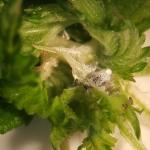 Woolly Apple Aphid overwinters as eggs in the cracks and crevices of Ulmus spp. host plants. As spring temperatures warm, these eggs hatch and stem mothers begin feeding on developing elm leaves. Their feeding and the feeding of the wingless nymphs they produce causes leaf distortion and a rosette to form on elm. If no elm is present, the aphids will complete their life cycle on apple year-round. Woolly apple aphid feeding distortion was seen on new elm foliage on the UMass Amherst campus on 5/1/2024.
Woolly Apple Aphid overwinters as eggs in the cracks and crevices of Ulmus spp. host plants. As spring temperatures warm, these eggs hatch and stem mothers begin feeding on developing elm leaves. Their feeding and the feeding of the wingless nymphs they produce causes leaf distortion and a rosette to form on elm. If no elm is present, the aphids will complete their life cycle on apple year-round. Woolly apple aphid feeding distortion was seen on new elm foliage on the UMass Amherst campus on 5/1/2024.- Woolly Beech Leaf Aphid overwinters as eggs in host plant bark crevices near buds. At budbreak, eggs hatch and wool covered aphids begin feeding on host plant leaf undersides (Fagus spp.). Even though aphid populations may be very noticeable, they seldom require chemical management.
- Woolly Elm Aphid overwinters as eggs hidden in cracks and crevices of elm bark. As leaves unfold in the spring, eggs hatch and young aphids feed on the underside of elm leaf tissue. These aphids mature and give birth to hundreds of additional females. Feeding causes leaves to curl around the aphids. Curled leaves may also turn reddish brown.
Beneficials/Non-Pests:
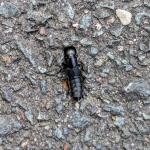 Rove Beetles are beneficial insects that may be confused with earwigs; however, they are members of the Family Staphylinidae. Adults have very short elytra (hardened hind wings) that do not fully cover the abdomen, thus exposing 6-7 segments. Unlike earwigs, they lack a pair of “pincers” at the end of the abdomen. Many rove beetles are facultative predators, and therefore are considered beneficial insects in our landscapes. Some even specialize on mosquito larvae or mites. Other species may eat fungi, plant parts, or even nematodes. Note: Rove beetles may lift the tip of their abdomen when startled or moving and are capable of secreting defensive substances from glands located there.
Rove Beetles are beneficial insects that may be confused with earwigs; however, they are members of the Family Staphylinidae. Adults have very short elytra (hardened hind wings) that do not fully cover the abdomen, thus exposing 6-7 segments. Unlike earwigs, they lack a pair of “pincers” at the end of the abdomen. Many rove beetles are facultative predators, and therefore are considered beneficial insects in our landscapes. Some even specialize on mosquito larvae or mites. Other species may eat fungi, plant parts, or even nematodes. Note: Rove beetles may lift the tip of their abdomen when startled or moving and are capable of secreting defensive substances from glands located there.
Report by Tawny Simisky, Extension Entomologist, UMass Extension Landscape, Nursery & Urban Forestry Program
Landscape Weeds
For information about identification of weeds noted below, check out UMass Extension's Weed Herbarium.
Crabgrass management in turf: At this time, we have moved passed the date where we can count on effectively managing crabgrass and other annual grassy weeds with a preemergence herbicide application. Regardless of whether a preemergence application was made, focus should now shift towards monitoring turf areas for the first signs of germinating crabgrass or other annual grassy weeds. After crabgrass has germinated, it can be controlled with several postemergence herbicides. Postemergence herbicides vary in their ability to control crabgrass at different stages of growth. Determination of the predominant growth stage will dictate the herbicide selection.
Ground ivy (Glechoma hederacea) in turf and landscapes: This often “tough-to-manage” weed is currently in full flower. Ground ivy cannot be effectively managed at this time of the growing season. The best control of ground ivy is achieved with an application of a broadleaf turf herbicide product that contains triclopyr in September and October. Ground ivy in landscape beds can be controlled now with a direct-spray application of glyphosate.
Garlic mustard (Alliaria petiolata): This biennial weed is considered invasive in Massachusetts and other northeast states. Second year plants are beginning to flower and produce fruit. An herbicide application now will control the second-year plants before they produce via seed as well as the first-year seeding plants that are germinating below the canopy of the second-year plants.
Japanese knotweed (Fallopia japonica): Do not attempt to control Japanese knotweed at this time, as herbicide applications are not effective when applied in the early part of the growing season. Stay tuned for knotweed management information in upcoming Landscape Messages.
Winter annual weeds in turf and landscape: Winter annual weeds are in full flower with some species just past their peak flowering period. Controlling these weeds now will decrease the number of seeds they produce. Winter annuals will complete their life cycle as the weather continues to warm. A fresh layer of landscape mulch will control them by smothering. Dense populations of winter annual weeds in turf areas that might be competing with newly establishing turf from seed may warrant the application of a broadleaf herbicide combination. Common winter annual weeds being observed now include mouse-ear cress (Arabidopsis thaliana), thymeleaf sandwort (Arenaria serpyllifolia), shepherd's-purse (Capsella bursa-pastoris), hairy bittercress (Cardamine hirsuta), sticky chickweed (Cerastium viscosum), spring whitlowgrass (Draba verna), henbit (Lamium amplexicaule), red deadnettle (Lamium purpureum), Virginia pepperweed (Lepidium virginicum), knawel (Scleranthus annuus), common chickweed (Stellaria media), corn speedwell (Veronica arvensis), and purslane speedwell (Veronica peregrina).
Report by Randy Prostak, Weed Specialist, UMass Extension Landscape, Nursery, and Urban Forestry Program
Additional Resources
Pesticide License Exams - The MA Dept. of Agricultural Resources (MDAR) is now holding exams online. For more information and how to register, go to: https://www.mass.gov/pesticide-examination-and-licensing.
To receive immediate notification when the next Landscape Message update is posted, join our e-mail list or follow us on Facebook.
For a complete listing of landscape, nursery, and urban forestry program upcoming events, see our calendar at https://ag.umass.edu/landscape/upcoming-events.
For commercial growers of greenhouse crops and flowers - Check out UMass Extension's Greenhouse Update website.
For professional turf managers - Check out our Turf Management Updates.
For home gardeners and garden retailers - Check out our home lawn and garden resources.
Diagnostic Services
UMass Laboratory Diagnoses Landscape and Turf Problems - The UMass Extension Plant Diagnostic Lab is available to serve commercial landscape contractors, turf managers, arborists, nurseries and other green industry professionals. It provides woody plant and turf disease analysis, woody plant and turf insect identification, turfgrass identification, weed identification, and offers a report of pest management strategies that are research based, economically sound and environmentally appropriate for the situation. Accurate diagnosis for a turf or landscape problem can often eliminate or reduce the need for pesticide use. For sampling procedures, detailed submission instructions and a list of fees, see the Plant Diagnostic Laboratory web site.
Soil and Plant Nutrient Testing - The University of Massachusetts Soil and Plant Nutrient Testing Laboratory is located on the campus of the University of Massachusetts at Amherst. Testing services are available to all. The lab provides test results and recommendations that lead to the wise and economical use of soils and soil amendments. For more information, including current turn-around times, visit the UMass Soil and Plant Nutrient Testing Laboratory web site. The lab is currently accepting orders for Routine Soil Analysis (including optional Organic Matter, Soluble Salts, and Nitrate testing), Particle Size Analysis, Pre-Sidedress Nitrate (PSNT), Total Sorbed Metals, and Soilless Media (no other types of soil analyses available at this time). Check for current turnaround time. Please plan for the fact that date of receipt in the lab is affected by weekends, holidays, shipping time, and time for UMass Campus Mail to deliver samples to the lab.
Tick Testing - The UMass Center for Agriculture, Food, and the Environment provides a list of potential tick identification and testing options at https://ag.umass.edu/resources/tick-testing-resources.
Acknowledgements: UMass Extension gratefully acknowledges the support of the following funding sources for the production of the Landscape Message –
- The Massachusetts Nursery and Landscape Association Fund
- The Massachusetts Department of Conservation and Recreation, Award #ISADCR28219926UMA24A
- Stakeholders like you! The Landscape Message is partially supported by educational program user fees.

